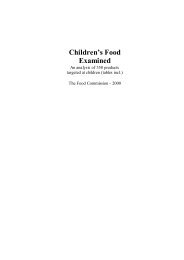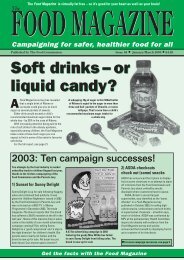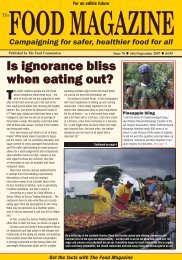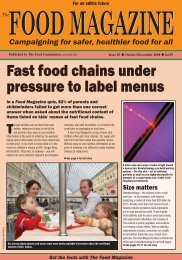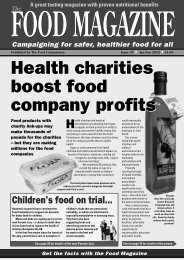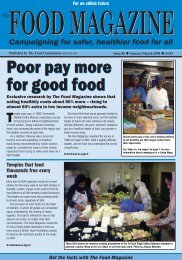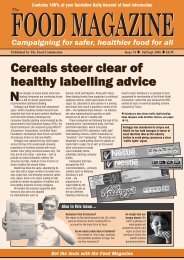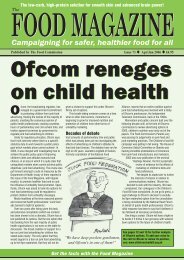Children's Nutrition Action Plan - The Food Commission
Children's Nutrition Action Plan - The Food Commission
Children's Nutrition Action Plan - The Food Commission
Create successful ePaper yourself
Turn your PDF publications into a flip-book with our unique Google optimized e-Paper software.
extrinsic sugars) than the<br />
recommended maximum. Typically,<br />
children consume approximately<br />
double the recommended<br />
maximum; 11<br />
♦ 30% of pre-school children show<br />
evidence of tooth decay – related to<br />
frequent non-milk extrinsic sugar<br />
consumption and infrequent teeth<br />
brushing (although frequent<br />
brushing of teeth did not appear to<br />
outweigh the damaging effects of<br />
frequent sugar consumption). 11 ,12,13, 22<br />
♦ <strong>The</strong> National Diet and <strong>Nutrition</strong><br />
Survey (1995) showed clear<br />
evidence of lower plasma levels of<br />
folic acid and vitamin C in children<br />
from low-income families 11 ;<br />
• A breakdown of the energy intake of<br />
British pre-school children shows:<br />
Sweets account for 11% of energy;<br />
Biscuits, buns, cakes and pastries: 9%;<br />
Soft drinks: 6%; Chocolate: 5%; Potato<br />
crisps, 4%; Savoury snacks: 4%. In<br />
contrast, total vegetables, fruits and nuts<br />
contributed 5%. 11<br />
• Half of UK children between the ages<br />
of 1 year and 18 months are given<br />
sugar-sweetened or artificially<br />
sweetened squash to drink. 14 In 1997, a<br />
survey of pre-school children showed<br />
that 86% were regularly drinking<br />
sweetened soft drinks. 15 <strong>The</strong> survey also<br />
showed that high levels of sugar<br />
consumption correlated with poor<br />
intakes of nutrients and dietary fibre. 15<br />
• A survey of 21 top-selling baby biscuits<br />
found many with excessive sugar levels<br />
(up to 50%). 16 Biscuit consumption<br />
showed the strongest links to poor<br />
dental health in infants. 11<br />
revision of training course to ensure that<br />
qualified nursery nurses are trained in issues<br />
relating to food and nurturing physical<br />
activity and movement in pre-school<br />
children. 22<br />
• Good quality research to aid the development<br />
of nutrition intervention programmes for preschool<br />
children, based on recommended<br />
guidelines from the Health Education<br />
Authority:<br />
♦ To allow for comparisons between data<br />
from different studies; 23<br />
♦ To build in evaluation to assist future<br />
intervention work; 23<br />
♦ To draw on best practice<br />
recommendations from HEA assessments<br />
of previous studies and interventions,<br />
such as appropriate assessment tools for<br />
young children, and the use of new<br />
technologies to support nutrition<br />
education; 23<br />
♦ To ensure that studies and interventions<br />
are in line with nationally accepted<br />
nutritional principles. 23<br />
• Studies of the long-term changes in behaviour<br />
of nutrition intervention with pre-school<br />
children. 23<br />
• A survey of nutritional knowledge/practice in<br />
nursery school staff.<br />
• A requirement on nursery schools to conform<br />
to a recognised nutritional programme, such<br />
as the Caroline Walker Trust guidelines or<br />
SM AP.<br />
<strong>The</strong> Children’s <strong>Nutrition</strong> <strong>Action</strong> <strong>Plan</strong>, published by <strong>The</strong> <strong>Food</strong> <strong>Commission</strong><br />
51



